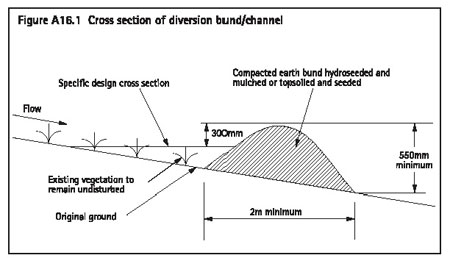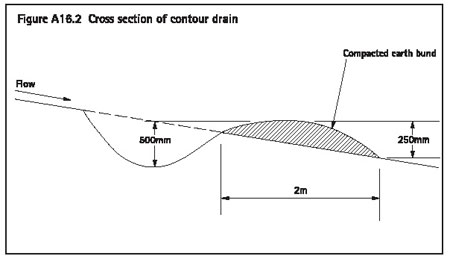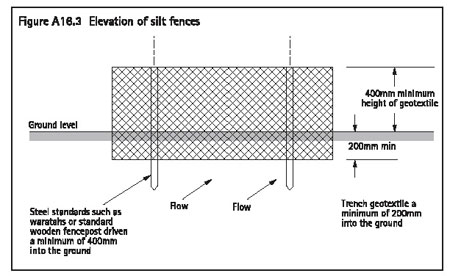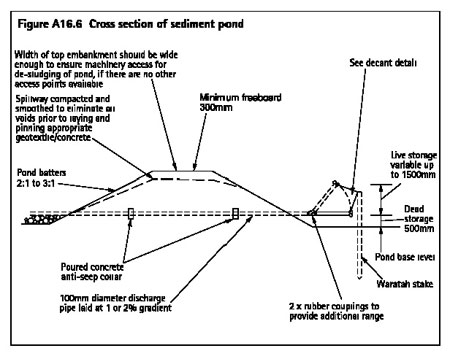Plans, policies and reports
District Plan Hauraki Gulf Islands Section - Proposed 2006
(Notified version 2006)
Street index |
Planning maps |
Text |
Appendices |
Annexures |
Section 32 material |
Plan modifications |
Help |
Notified - Home |
Decision - Home
Appendix 16 - Erosion and sediment control guidelines for earthworks
1.0 Introduction
2.0 General guidelines
3.0 Runoff control methods
4.0 Sediment control methods
5.0 Application to typical house site
6.0 Keeping the roads clean
7.0 Pumping water from the site
8.0 Additional information
1.0 Introduction
Uncontrolled earthworks activities can remove or smother
valuable vegetation and cause silt runoff into streams and coastal waters.
This silt can smother aquatic life and affect fish feeding and breeding
areas. If a number of earthworks activities are occurring over time
in the same area, there will be a cumulative impact which will compound
the adverse effects on the environment.
By choosing the right methods when undertaking earthworks
you can prevent unnecessary soil erosion and help the community protect
the streams and coastal areas of the islands. This publication provides
information about erosion and sediment control measures to assist you
when planning and carrying out earthworks.
The landowner and the earthworks contractor are both
responsible for making sure that any activity disturbing the soil is
carried out in a way to prevent soil erosion and to stop sediment entering
waterways.
A resource consent will be required for some earthworks,
depending on the area where the work is to take place and the size of
the job. You should check with the council to find out whether a consent
is needed. For very large earthworks, works within floodplains for
watercourses (including diversion) and cultivation of soil for commercial
crop production, you may also require a consent from the Auckland Regional
Council. The ARC has comprehensive guidelines which will be helpful
for larger projects.
Regardless of the size of the earthworks, you are required
to take the appropriate measures to prevent soil loss and erosion.
This applies even when a resource consent is not needed.
Some facts about siltation:
- Earthwork sites can produce up to 100
times as much sediment as from grassed areas.
- Doubling the angle of the slope produces
more than a two-fold increase in silt.
2.0 General guidelines
- Keep the area of earthworks small. Stage
earthworks and expose only as much ground is needed at any one time.
- Keep as much grass or natural vegetation
as possible around the sides and bottom of a site. Do not mow or park
machines or vehicles on this during the project.
- Divert runoff around the bare areas
of the site using diversion bunds / channels, or contour drains. Details
on these each of these measures can be found in the section of runoff
control below.
- Install a stabilised entranceway
(gravel/wooden planks etc) prior to commencing work to reduce dirt tracking
onto the road.
- Retain sediment on the site. Use
earth bunds, silt ponds, silt fences or haybales and install them as
close to bare areas as practicable. Details on each of these measures
can be found in the section on sediment control below.
- Take extra care near watercourses.
- Cover any soil stockpiles or stabilise
with mulch or vegetation.
- Ensure that earthworks equipment
is only washed in areas of the site which have appropriate sediment
controls. Similarly do not leave muddy equipment standing on areas of
the site which do not have appropriate sediment controls.
- Retain and maintain the control
measures until all bare areas on the site have been protected against
erosion (by concrete pad, gravel, seal, grass, vegetation etc). Cover
bare areas as quickly as possible.
- At the building stage, install
spouting, downpipes and temporary pipes as soon as the roof is on to
convey roof water away from bare areas and to an erosion proof outfall.
3.0 Runoff control
methods
3.1 Diversion bunds/channels
- These are used to transfer all runoff
around a site, to silt ponds etc.
- They need to be big enough to take
the flow from a 20 year storm event. The design flow, Q, can be approximated
from the formula:
Q = 0.15 x Area (ha) (m3/s)
Indicative channel capacities for different flows
are as follows (these assume a grassed channel on a 2 per cent grade,
side slopes of 1:1 for the bund and 3:1 for the channel):
|
Depth (m) |
Flow (m3/s) |
|
0.2 |
0.1 |
|
0.3 |
0.3 |
|
0.4 |
0.6 |
- Soil channels that have a slope
of more than 2 per cent need to protected (armoured) against erosion.
This can be achieved by laying and pinning fabric eg polythene,
grassing, placing rock etc.

3.2 Contour drains
- These are temporary runoff control measures
and are either constructed daily or in the event of rain to intercept
runoff on the site.
- Intercepted runoff must be directed
to a stable outlet.
- They do not need calculations for
their implementation. Try to keep their grade at 2 per cent or
less, and install more drains as the land becomes steeper.

4.0 Sediment control
methods
4.1 Silt fences
- For catchments of 0.5 ha or less. Construct
on the contour.
- Make sure that the fabric is well
dug in (200mm deep and backfilled).
- Posts / waratahs should
be no more than 2m apart.
- The fences can be strengthened with
tensioned wire, and with chain mesh netting.

4.2 Haybales
- These should be used only when there
is 20m or less length of slope above them and where the slope is less
than 20 per cent.
- They should be placed on the contour
and anchored by staking.

4.3 Earth bunds
- These are mini silt ponds to retain sediment.
- Catchment should be 0.3 ha or less.
- They should be cleaned out when
20 per cent full of deposited sediment.

4.4 Sediment
ponds
- These are used when catchments are greater
than 0.3 ha.
- The maximum catchment should be
5 ha.
- Do not construct in streams.
- Capacity is generally 2m3
per 100m2 of site area.
- They should be cleaned out when
20 per cent full of deposited settlement.


5.0 Application
to typical house site
Figure A16.8 shows how the runoff and sediment controls
can be applied to a typical house site.

6.0 Keeping the
roads clean
It is important that soil from the site is not spread
onto the road by vehicle tyres. To prevent this from occurring a stabilised
entranceway must be built. The simplest method is to spread metal aggregate
on all exitways from the site, where the soil will have a chance to
fall off before the vehicle enters the road. Other methods for larger
sites are cattle grids or wheel washes. The site manager or site owner
is responsible for cleaning up any spilt soil or other materials that
get on to the road from the site. Remember also to protect the footpath,
berm and kerb from damage by crossing vehicles.

7.0 Pumping water
from the site
If it is necessary to remove water from trenches or
other areas of the site, then this should be done in a manner to prevent
sediment in the water from entering any drain or watercourse. Water
should not be taken from the bottom of any trench and sediment should
be properly filtered out from the dirty water by some appropriate means
such as the use of silt fences. It will often be necessary to pump
water into a tank and discharge it into a silt pond.

8.0 Additional
information
For more details about erosion and sediment control
measures, see the Auckland Regional Council publication “Erosion
and Sediment Control Guidelines for Land Disturbing Activities in the
Auckland Region” (Technical Publication Number 90).

